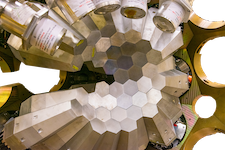Speakers
Description
In the proposed experiment, we plan to investigate the properties of nuclei close to the doubly-magic $^{56}$Ni isotope ($N = Z = 28$) using the Coulomb excitation method. Specifically, we propose to study the electromagnetic structure of $^{60}$Ni with the AGATA spectrometer coupled to the SPIDER heavy-ion %detection system. A $^{60}$Ni beam of 240 MeV energy and 1 pnA from the TANDEM-XTU accelerator will be used, impinging on a $^{208}$Pb target.
The results of the proposed experiment, along with those from the $^{58}$Ni Coulomb-excitation experiment already performed at INFN LNL with the GALILEO+SPIDER setup, will allow us to bring an important experimental input to investigate fundamental aspects of the structure of doubly-magic nuclei and in their vicinity. In particular, with the proposed Coulomb-excitation project we will provide new inputs to discuss some open questions, such as:
- Are nuclei nearby doubly-magic isotopes spherical in their ground states?
- What is the reason for the emergence of collectivity close to shell closures? And what is the potential role of triaxiality in forming deformed shapes in these regions?
- How "good" the 28 magic number is?
This experiment will be complemented by the data from the Coulomb-excitation experiment of a $^{60}$Ni beam on the medium-mass $^{110}$Cd target performed with the AGATA+SPIDER setup in June 2022. The simultaneous analysis of these two datasets will provide sensitivity to second-order effects influencing the Coulomb-excitation cross sections.

